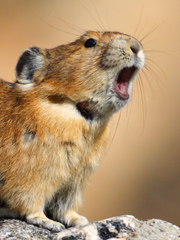|
AMERICAN PIKA } Ochotona princeps

|
RANGE: Mountainous regions throughout the western United States and Canada: the Rocky Mountains from northern New Mexico to central British Columbia, the Great Basin, and the Sierra Nevada of California through the Cascade Range of Oregon and Washington
STATUS: Not listed under the Endangered Species Act; the pika is included on the IUCN Red List as a species of Least Concern, but the mammal has experienced significant lower-elevation population losses and is severely threatened by global warming.
THREATS: Primarily global warming, through direct impacts from rising temperatures as well as potential changes in vegetation
Tiny, round-bodied rabbit relatives with fluffy, peppery fur, American pikas are not only cute but smart: Throughout the growing season in the mountains of the American West, they cut, sun-dry, and later store vegetation to eat during the long winter months. Unfortunately, rising temperatures caused by global warming shorten pikas’ food-gathering period, change the types of plants available, shrink the alpine meadows where they feed, and reduce the insulating snowpack that protects them from winter cold snaps. Because pikas are specially adapted for cold climates, warming can even directly kill them through overheating. Still, despite the danger to pikas — and despite petitions and legal action by the Center for Biological Diversity — neither the state of California nor the U.S. Fish and Wildlife Service has yet given the squeaky-voiced mammal the Endangered Species Act protection it needs.
LEARN MORE ABOUT THE AMERICAN PIKA
|